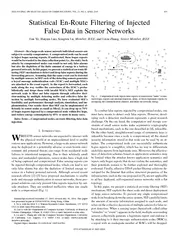/


23 NO 4 APRIL 2005 839 Statistical EnRoute Filtering of Injected False Data in Sensor Networks Fan Ye Haiyun Luo Songwu Lu Member IEEE and Lixia Zhang Senior Member IEEE Abstract In a largescale sensor network individual sensors are subject to se ID: 83674
Download Pdf The PPT/PDF document "IEEE JOURNAL ON SELECTED AREAS IN COMMUN..." is the property of its rightful owner. Permission is granted to download and print the materials on this web site for personal, non-commercial use only, and to display it on your personal computer provided you do not modify the materials and that you retain all copyright notices contained in the materials. By downloading content from our website, you accept the terms of this agreement.
IEEEJOURNALONSELECTEDAREASINCOMMUNICATIONS,VOL.23,NO.4,APRIL2005839StatisticalEn-RouteFilteringofInjectedFalseDatainSensorNetworksFanYe,HaiyunLuo,SongwuLu,Member,IEEE,andLixiaZhang,SeniorMember,IEEEInalarge-scalesensornetworkindividualsensorsaresubjecttosecuritycompromises.Acompromisednodecanbeusedtoinjectbogussensingreports.Ifundetected,thesebogusreportswouldbeforwardedtothedatacollectionpoint(i.e.,thesink).Suchattacksbycompromisednodescanresultinnotonlyfalsealarms Fig.1.Compromisednodeinjectsfalsereportsofnonexistenttanksevents.Suchbogusreportscanmisleadreactions,delay,orblocklegitimatereportsby 840IEEEJOURNALONSELECTEDAREASINCOMMUNICATIONS,VOL.23,NO.4,APRIL2005Asareportisforwardedthroughmultiplehopstowardthesink,eachforwardingnodeveriesthecorrectnessoftheMACscar-riedinthereportwithcertainprobabilityanddropsthereportifanincorrectMACisdetected.TheprobabilityofdetectingincorrectMACsincreaseswiththenumberofhopsthereporttravels.Duetothestatisticalnatureofthedetectionmechanism,afewbogusreportswithincorrectMACsmayescapeen-routelteringandreachthesink.However,thesinkcanfurtherverifythecorrectnessofeachMACandrejectfalsereports.Thecontributionofthispaperistwofold.First,weproposeakeyassignmentmethoddesignedforen-routedetectionoffalsereportsinthepresenceofcompromisednodes.Second,wedevelopmechanismsforcollectivedatareportendorsement,en-routereportltering,andsinkverication.Toourbestknowledgethisisthersteffortthataddressesfalsereportdetectionproblemsinthepresenceofcompromisedsensor.Wehaveevaluatedourdesignthroughanalysis,imple-mentation,andsimulations.OurresultsshowthatSEFisabletodropupto70%ofbogusreportsinjectedbyacompromisednodewithinvehops,andupto90%withintenhopsalongtheforwardingpaths.Theen-routelteringaddscomputationcomplexityoflessthan1mstimeandabout75 energyoneachforwardingnode,whilereducingtotalenergyconsumptionby65%ormoreinmanyscenarios.Therestofthepaperisorganizedasfollows.SectionsIIandIIIpresentthemodelanddesignofSEF.SectionIVdis-cussestheparametersettingandanalyzestheeffectivenessandenergysavingsachievedbySEFthroughmeasurementsfromimplementation,andevaluatesthedesignthroughsimulations.AnumberofpracticalissuesandfutureworkarediscussedinSectionV.SectionVIcomparesSEFwiththerelatedworkandSectionVIIconcludesthepaper.II.SODELSANDA.SensorNetworkModelWeconsiderasensornetworkcomposedofalargenumberofsmallsensornodes.Wefurtherassumesthatthesensornodesaredeployedinhighdensity,sothatastimulus(e.g.,atank)canbedetectedbymultiplesensors.Eachofthedetectingsensorsreportsitssensedsignaldensityandoneofthemiselectedasthecenter-of-stimulus(CoS)node.TheCoScollectsandsum-marizesallthereceiveddetectionresults,andproducesasyn-thesizedreportonbehalfofthegroup.Thereportisthenfor-wardedtowardthesink,potentiallytraversingalargenumberofhops(e.g.,tensormore).Thesinkisadatacollectioncenterwithsufcientcomputationandstoragecapabilities,anditmayalsoimplementadvancedsecuritysolutionstoprotectitself.Duetocostconstraintsweassumethateachsensornodeisequippedwithtamper-resistanthardware.However,densede-ploymentenablescross-vericationofareportedeventamongmultiplesensorseveninthepresenceofoneormorecompro-misednodes.SEFdesignharnessestheadvantageoflarge-scale.Ratherthanrelyingonasmallnumberofpowerfulandexpen-sivesensors,SEFutilizeslargenumbersofsmallsensorsforreliablesensingandreporting.Tamper-resistanthardwarecanpreventtheexposureofstoredsecrets[6]evenwhenanodeiscapturedbytheattacker.B.ThreatModelWeassumethattheattackermayknowthebasicapproachesofthedeployedsecuritymechanisms,andmaybeabletoeithercompromiseanodethroughtheradiocommunicationchannel,orevenphysicallycaptureanodetoobtainthesecurityinfor-mationinstalledinthenode.However,weassumethatattackerscannotsubvertthedatacollectionunit,i.e.,thesink,becausetheprotectionatthesinkispowerfulenoughtodefeatsuchsub-versionefforts.Oncecompromised,anodecanbeusedtoin-jectfalsereportsintothesensornetwork.Nodeandmessageauthenticationmechanisms[1][3]preventnaiveimpersonationofasensornode.However,theycannotblockfalseinjectionofsensingreportsbycompromisednodes.Besidesfalsedatainjection,acompromisedsensornodecanlaunchvariousotherattacks.Itcanstallthegenerationofreportsforrealevents,blocklegitimatereportsfrompassingthroughit(whichwecallfalsenegativeattacks),orrecordandreplayoldreports,etc.Asthersteffortintacklingthethreatsfromcompromisedcomponents,thispaperfocusesonthedetectionoffalseeventreports,whichwecallfalsepositivesattacks,in-jectedbycompromisednodes.Weplantoaddressotherattacksinsubsequentefforts.III.STATISTICALILTERINGInthissection,wepresenttheSEFdesign.SectionIII-Agivesanoverviewofthedesign,followedbyamoredetaileddescrip-tionofthethreemajorcomponentsofSEF,keyassignmentandreportgeneration,en-routeltering,andsinkveriinSectionsIII-BIII-D,respectively.FinallywediscusshowtoreduceoverheadwithtwodifferenttechniquesinSectionIII-E(withmoredetailedcomparisoninSectionIV-B).A.OverviewSEFaimsatachievingthefollowinggoals.Earlydetectionoffalsedatareports:bydetectingfalsere-portstheusercanavoidrespondingtofabricatedevents.Althoughthedetectioncanbedoneafterthedatareportsarriveatthesink,en-routeearlydetectionanddroppingoffalsereportscanconserveenergyandbandwidthre-sourcesofsensornodesalongdataforwardingpaths.Lowcomputationandcommunicationoverhead:Giventheresourceconstraintsoflow-endsensornodes,weruleoutsolutionsbasedoncomputation-intensiveasymmetriccryptographyandonlyuseefcientone-wayfunctions.SEFconsistsofthreecomponentsthatworkinconcerttode-tectandlteroutforgedmessages:1)eachlegitimatereportcar-riesmultipleMACsgeneratedbydifferentnodesthatdetectthesamestimulus;2)intermediateforwardingnodesdetectincor-rectMACsandlteroutfalsereportsen-route;and3)thesinkveriesthecorrectnessofeachMACandeliminatesremainingfalsereportsthateludeen-routeInSEF,thesinkmaintainsaglobalkeypool.EachsensorstoresasmallnumberofkeysthataredrawninarandomizedIthasbeenreportedthatencryption/decryptionoperationsbasedonasym-metrickeysconsumetwotothreemagnitudesmoreenergythansymmetricones,sometimessigningabitisevenmoreexpensivethantransmittingabit[7]. etal.:SEFOFINJECTEDFALSEDATAINSENSORNETWORKSfashionfromtheglobalkeypoolbeforedeployment.When-everastimulusappearsinthesensoreld,multiplesurroundingnodescandetecttheeventandaCoSnodeiselectedtogeneratetheeventreport.EachdetectingsensorendorsesthereportbyproducingakeyedMACusingoneofitsstoredkeys.TheCoSnodecollectstheMACsandattachesthemtothereport.ThissetofmultipleMACsactsastheproofthatareportislegitimate.AreportwithinsufcientnumberofMACswillnotbeforwarded.Thekeyassignmentensuresthateachnodecangenerateonlyproofforareport.Onlybythejointeffortsofmultipledetectingnodescanthecompleteproofbeproduced.AsinglecompromisednodehastoforgeMACstoassembleaseeminglycompleteproofinorderfortheforgeddatareporttobefor-warded.Becausenodessharecommonkeyswithcertainprob-abilities,whenthereportwithforgedMACsisforwardedbyintermediatenodes,thenodescanverifythecorrectnessoftheMACsprobabilistically,thusdetectinganddroppingfalseonesThesinkservesasthenalgoal-keeperforthesystem.Whenitreceiveseventreports,thesinkcanverifyalltheMACscarriedinthereportbecauseithascompleteknowledgeoftheglobalkeypool.FalsereportswithincorrectMACsthatsneakthroughlteringwillthenbedetected.Severalquestionsintheabovedesignmustbeanswered.1)Howshouldthekeysbeassignedtonodestopreventacompromisednodefromforgingthecompleteproofwhileenablingvericationbyintermediateforwardingnodes?2)Howarefalsereportsdetectedandlteredouten-routebyforwardingsensors?3)Whatproceduresdoesthesinkfollowtodetectanyre-mainingforgedreports?4)HowcanthesizeofthemultipleMACscarriedinareportbekeptminimaltoreducetheoverhead?Therestofthissectionaddresseseachofthesefourquestionsinorder.B.KeyAssignmentandReportGenerationThereisapregeneratedglobalpoolof keys ,dividedinto nonoverlappingpartitions .Eachpartitionhas keys(i.e., ),andeachkeyhasauniquekeyindex.Asimplewaytopartitiontheglobalkeypoolisasfollows: Beforeasensornodeisdeployed,theuserrandomlyselectsoneofthe partitions,andrandomlychooses keysfromthispartitiontobeloadedintothesensornode,togetherwiththeassociatedkeyindices(seeFig.2,foranexample).Whenastimulusappears,allsurroundingnodesthatdetectthesignalwillprepareaneventreportintheformof ,where isthelocationoftheevent, isthetimeofdetection, isthetypeofevent.Similarto[8],eachdetectingnodesetsarandomtimer,uponthetimerexpirationitbroadcastsitsvaluesof .Ifanothernodendsthedifferencebe-tweenthebroadcastvaluesandwhatitobservesiswithinsomeThereportmayalsocontainotherinformationabouttheevent.Tosimplifypresentation,weonlylisttheabovethree. Fig.2.Exampleofaglobalkeypoolwithpartitionsandfournodes,eachofwhichhaskeysrandomlyselectedfromonepartition.Inarealcanbemuchlarger.nederrorrange,itacceptsthemandcancelsitsowntimer.Otherwise,itbroadcastsitsownobservedvaluesonexpirationofitstimer.ThenodewhosebroadcastvaluesareacceptedbyothersbecomestheCoSnode.Whenrealeventsoccurinthesensoreld,theCoSelectionallowsdetectingnodestogenerateMACsforthesamereportcontentintheabsenceofcompromisednodes.Thepredeerrorrangeisdecidedbasedonthesensingaccuracyofnodesandtheapplicationsrequirementstosuppressduplicatedatare-portgeneration.However,whennorealeventoccurs,well-be-havingsensorswillnotsendoutdetectionresultsandtheasso-ciatedMACs.Therefore,thecompromisednode(s)(inaworstcasescenario,eventheCoSitselfmaybecompromised)areforcedtoforgeMACsinordertogeneratefalsereports,whichcanbesubsequentlydetectedbySEF.However,notethatSEFdoesnotaddressfalsenegativeattacks.Acompromisednodecanstalltheproperreportingofarealeventbysendingmanyincorrectvaluestoblockthecommunicationchannel.Forap-plicationsthatrequiremorecomplexdecisionmakingwherethereportcontainsmorethanthetargettypeandeachsensingnodehasverydifferentdetectingresult,aconsensusneedstobereachedbeforethereportcanbeendorsed,whichisbeyondthescopeofthispaper.Aftertheelectionprocessnishes,adetectingnode domlyselects ,oneofits keys,andgeneratesaMAC (1)where denotesstreamconcatenationand putestheMAC ofmessage usingkey .Manycrypto-graphicone-wayfunctionsmayservethispurpose[9].Thenodethensends ,thekeyindexandtheMAC,totheCoS.TheCoScollectsallthe sfromdetectingnodesandclassifyMACsbasedonthekeypartitions.WedeneMACsgeneratedbykeysofthesamepartitionasonecategory.SupposeCoScol- categories( ).Fromeachcategory,theCoSran-domlychoosesone tupleandattachesittothereport.nalreportsentoutbytheCoStothesinklookslike Thechoiceofparameter tradesoffbetweendetectionpowerandoverhead.Thesinkcansetasystem-widevaluefor sothateachreportcarriesexactly keyindicesofdistinctpartitionsand MACs.Areportwithlessthan MACsorkeyindices,ormorethanonekeyindexinthesamepartition,willnotbeforwarded.Alarger valuemakesforgingreportsmorecultatthecostofincreasedoverhead.Whenmorethan 842IEEEJOURNALONSELECTEDAREASINCOMMUNICATIONS,VOL.23,NO.4,APRIL2005 Fig.3.Operationsinen-routecategoriesexist,theCoScanrandomlychoose ofthem.Inareaswithsparsesensordeployment,therecouldbelessthan categories.Thenodedensityshouldbehighenoughsothatsuchcasesrarelyhappen.MoreanalysisonsettingparameterswillbegiveninSectionIV.C.En-RouteFilteringAsaresultoftherandomizedkeyassignment,eachfor-wardingnodehascertainprobabilitytopossessoneofthekeysthatareusedtogeneratetheMACsinadatareport,i.e., ,andverifythecorrectnessofthecorre-spondingMAC,i.e., .AcompromisednodehaskeysfromonlyonepartitionandcanonlygenerateMACsofonecategory.Since MACsofdistinctcategoriesand keyindicesofdistinctpartitionsmustbepresentinalegitimatereport,thecompromisednodeneedstoforgetheother keyindicesandcorrespondingMACs.Thisexplainswhytheglobalkeypoolispartitioned:Hadeachnodecarriedkeyschosenfromtheentirepool,onecompromisednodecanuse ofitskeystogeneratemultipleMACs,whichwouldbeindistinguishablefromthosegeneratedby Whenanodereceivesareport,itrstexamineswhetherthere keyindicesofdistinctpartitionsand MACsinthepacket.Packetswithlessthan keyindices,orlessthan MACs,ormorethanonekeyindexinthesamepartitionaredropped.Thenifthenodehasanyofthe keysindicatedbythekeyindices,itreproducestheMACusingitsownkeyandcomparestheresultwiththecorrespondingMACattachedinthepacket.Thepacketisdroppediftheattachedonediffersfromthereproduced.Onlyiftheymatchexactly,orthisnodedoesnotpossessanyofthe keys,thenodepassesthepackettothenexthop.Thepseudocodeforen-routelteringoperationsisgiveninFig.3.IfanattachedMACdiffersfromtheonelocallyproducedbyaforwardingnode,itindicatesthatthereportwasnotgener-atedwiththecorrectkey.SuchaMACisconsideredforged,andthepacketisdropped.Notethataforwardingnodesendsthereportdownstreamifitdoesnothaveanyofthe keys,be-causethereportmightbealegitimateonewithMACsbykeysnotpossessedbythisnode.ThismaycauseaforgedMACtoescapethescreeningofcertainnode,buttheforgedreportwillbedetectedanddroppedwithhigherandhigherprobabilitiesasittravelsmoreandmorehops.Thedetectionpowerofasinglesensorisconstrained,butthecollectivedetectionpowergrowsasmorenodesdeliverthereport.WewillfurtheranalyzetheperformanceinSectionIV.D.SinkVeriÞcationWhenthesinkreceivesareport,itcancheckthecorrectnessofevery becauseithasallthekeys.AnyforgedMACthateludestheen-routelteringbychancewillbecaught.Whenthesinkreceivesareport,itrstexamineswhetherthereportcar- keyindicesofdistinctpartitionsand MACssimilarly.Itthenrecomputeseachofthe MACsandcomparesthemwiththeattachedones.Ifonemismatchhappens,thepacketisAnyforgedMACthatpassesen-routelteringcanbede-tectedbythesink.Thesinkservesasthenaldefensethatcatchesfalsereportsnotlteredoutbyforwardingnodes.AslongasaMACisforged,thesinkcandetectanddiscardthereport.Therefore,SEFcandetectbogusreportsforgedbyanat-tackercompromisingkeysinupto partitions.WefurtheranalyzeSEFsdetectionpowerinSectionIV.E.ReducingtheMACSizeInadditiontosensingdata,eachreportcarries keyindicesandMACs,bothofwhichincreasethepacketlengthandtrans-missionenergyconsumption.Somesensornetworksmayalsohavestringentlimitonthepacketlengthduetohardwareorsoft-wareconguration(e.g.,TinyOS[10]useslessthan36-bytepackets),orpotentiallyhigherrorrates.InSEFMACposesamainsourceofpacketsizeincrease.However,wecannotreducetheMACsizebydecreasing ,becauseatoosmall valuere-ducesSEFsfalsedetectionpower.Inthefollowing,wepresenttwotechniquesforreducingtheoverheadwhileretainingcer-tainsecurityprotectionstrength.Thisraisesaninterestingques-tion,whichtechniqueisbetter?WewillcomparetheirstrengthinSectionIV-Bandpointoutunderwhatconditionswhichisbetter.1)ShorterMACs:OnemethodistouseMACsofshorterlengths.Thisreducestheoverheaddirectly,atthecostofin-creasingthechancethatanattackercantheMACcor-rectly,butitstillrequiresmultiplenodestocollectivelyendorseanevent.2)BloomFilters:Weproposeasecondtechnique,Bloomlter,whereweuseamuchshorterbit-string,insteadofalistofMACs,toreducepacketsizewhileretainingthefalsedatadetectingpower.lterisawell-knowndatastructurethatcanbeusedforefcientmembershipchecking,i.e.,givenanelement,whetheritisinapredenedset.ABloomlterismadeofaset usingastringof bitsand denthashfunctions [11].Each mapsanitem uniformlytotherange ,eachofwhichcor-respondingtoabitinthe -bitstring.(Notethatweuse , , , fordifferentmeaningsinthissection).The -bitstringisinitiallysetto0.Foreachelement ,wehashitwithallthe hashfunc-tionsandobtaintheirvalues .Thebitscor-respondingtothesevaluesarethensetto1inthestring.Note etal.:SEFOFINJECTEDFALSEDATAINSENSORNETWORKS Fig.4.Bloomlterthatrepresentselementsusingastringofbitsandhashfunctions,eachmapsanyelementtorange (s )andh (s bothmaptobit6.thatmorethanoneofthe valuesmaymaptothesamebitinthestring(seeFig.4,foranexample).Tondwhetheranitem ,bits arechecked.Ifallofthemare1, iscon-sideredtobelongto ; isdenitelynotin ifatleastoneofthemis0.ltermayyieldfalsepositives,i.e.,anelementisnot butitsbits arecollectivelymarkedbyotherelements .Ifthehashisuniformlyrandomoverthe values,theprobabilitythatabitis0afterallthe elementsarehashedandtheirbitsmarkedis .Therefore,theprobabilityforafalsepositive(i.e.,the bitsofanelement alreadymarked)is CertainchangesareneededtouseBloomlterforSEF.TheCoSapplies system-widehashfunctionstomapthe MACs(eachwith bits)toa -bitstring wherewehave toreducepacketsizeand retainen-routelteringcapability.These functionsareknownbyeverynodeandthesink.Foreach ,wehave if , s.t. otherwise nalreportsentbytheCoStothesinkis Now,weneedtomodifyboththeen-routinglteringandsinkvericationprocedurestoaccommodatetheuseofBloomlter.Whenaforwardingnodereceivesthereport,itcheckswhetherthereare keyindicesofdistinctpartitionsandan -bitBloom withatmost s.Ifithasoneofthekeys,itrepro-ducesthe hashvaluesandverieswhetherthecorrespondingbitsares.Thedetailsoftheforwardingprotocolforanin-termediatesensornodeareasfollows.1)Checkthat keyindices andan -bitstring existinthepacket,andthereareatmost sin ;dropthepacket,otherwise.2)Checkthe keyindices belongto distinctpartitions;dropthepacket,otherwise.3)Ifithasonekey ,itcomputes asin(1).Then,itcomputes andseeifthecorrespondingbitis Thepacketisdroppedifatleastoneofthemisitisforwardedtothenexthopifallofthemare4)Ifitdoesnothaveanyofthekeysin sendsthepackettothenexthop.Whenthesinkreceivesthereport,itcheckswhetherthereare keyindicesofdistinctpartitionsanda -bit withatmost sinthepacket.ItthenregeneratestheBloomlterandcompareswiththatcarriedinthepacket.Specically,thesinkpreparesan -bitstring ,withallbitssettoForeachkey ,itcomputestheMAC andmarksthecorrespondingbits Thepacketisacceptedonlyif isidenticalto BothshorterMACsandBloomltercangreatlyreducethepacketsize.Asanexample,assumethateachkeyindexis10bits,eachMACis bits, keyindices, MACsarerequiredforeachreport.Theytake370bits(about46bytes).UsingeithershorterMACs,oralterof hashfunctions,whichmap5MACsto bitstring,thetotalrequiredspaceisreducedto30%(about14bytes).Ontheotherhand,theymaintainreasonablelevelsofsecuritystrengthanddetectingpower,aswewillcompareandanalyzeinSectionIV-B.IV.PVALUATIONInthissection,werstquantifytheeffectivenessofen-routelteringinSectionIV-A,andcomparethesecuritystrengthsofshorterMACsandBloomlter,inSectionIV-B.Basedontheresults,wediscussinSectionIV-ChowtochooseappropriateparameterstooptimizethedetectingpowerofSEF.WethendescribeitsimplementationinSectionIV-DandanalyzeSEFenergysavingsthroughdroppingbogusdatainSectionIV-E.Finally,weprovidesimulationresultsinSectionIV-F.SinceSEFreliesonthe carriedMACstodetectfalsere-ports,anattackerthatcompromiseskeysin ormoredistinctpartitionscansuccessfullyfabricatereports.SEFcannotdetectordropsuchforgedreports,whichisalimitationofthecurrentdesign.Intherestofthissection,weanalyzecaseswheretheattackerhaskeysin ( )distinctpartitions.A.En-RouteFilteringEffectivenessTheattackercannotgeneratecorrectMACsofother distinctcategories.Tohavehisdatareportsforwarded,theat-tackerhastoforge keyindicesofdistinctpartitions MACs.Werstcomputetheprobabilitythatafor-wardingnodehasoneofthe keys,thus,beingabletodetectanincorrectMACanddropthereport.WeanalyzethescenariosthatusetheoriginalMACshere;SectionIV-Bexam-inesthescenariosusingshorterMACsorBloomlterandshowsthattheresultsarealmostthesame.Iftheattackerrandomlychooses otherpartitionsandrandomlychoosesakeyindexineachpartition,thentheprob-abilitythatanodehappenstohaveoneofthe keys,denotedby is (2) 844IEEEJOURNALONSELECTEDAREASINCOMMUNICATIONS,VOL.23,NO.4,APRIL2005 Fig.5.Portionofdroppedfalsereportsasafunctionofthenumberoftraveledhops.Thethreecurvesarefor ,0.1,0.05,wheretheattackerhaskeysin1,3,and4distinctpartitions,respectively.EachreportcarriesMACs. isthenumberofkeyseachnodepossesses, isthenumberofkeysapartitionhas,and isthenumberofkeyTheexpectedfractionoffalsereportsbeingdetectedanddroppedwithin hopsis Theaveragenumberofhopsthataforgedreporttraversesisgivenas Fig.5illustrateshowthedetectedfractionincreasesasthenumberofhops grows.Consideranexampleof partitions, keysperpartition,eachnode keys,andeachpacketcarries MACs. ,3,and4,wehave ,0.1,0.05,respec-tively.Fig.5showsthat90%falsereportsaredroppedwithintenhopsiftheattackerhaskeysinonepartition,and80%aredroppedwithin15hopsiftwopartitions.Intheworstcase,onlyoneMACisincorrect,80%falsereportsaredroppedin32hopsandtheytravel20hopsonaverage.B.SecurityStrengthsofShorterMACsandBloomFilter1)FalsePositiveattheSink:Now,weanalyzeandcom-parethefalsepositiveprobabilities(i.e.,afalsereportisnotdetectedandnallyacceptedbythesink)ofthetwooverhead-reducingtechniques:shorterMACsandBloomlter.Thisisimportanttocheckwhethertheymaintainsufcientsecurityprotectionagainstfalsiedreports,andidentifyunderwhatcon-ditionswhichisbetter.Weassumebothtechniquesuse inMACsoraBloomlter.EachshorterMACisof bits,thus,thechancethatanattackercansuccessfullyguessoneMACis .Thechanceheguessesallthe remainingMACsinadditiontothe MACshealreadyknows,thuscheatingthesinksuccessfully, WithBloomlter,theattackerhastwowaystoattack.Heknowsthe hashingresultsof correctMACs,thus,at sofan -bitBloomlter(notethatmorethanoneresultmaymaptothesamebit).Therefore,heneedstoguesstheremaining bitpositionsofthe forgedMACs.Sincedifferenthashingsmaymaptothesamebit,the hashresultsofforgedMACsmaptoatleastoneandatmost distinctbitpositions.Thetotalnumberofbitpatternsby hashresultsis Randomlyguessingoneofthemhas chanceofsuccess.Asecondwayofattackisnottomarkanyadditionalbit,buttosendtheBloomlterofthe correctMACsdirectly.GiventhefalsepositiveofBloomlters,itispossiblethatthebitsoftheremaining MACsarealreadymarked.Theprobabilityisgivenby .Given ,and ,theaboveprobabilitycanbeminimizedas Undertherstattack,BloomlterisalwaysbetterthanshorterMACs.Thisisbecausetheattackerneedstoguessinalargerspace( versus ).Asanexample,withthesameoverheadof64bits,eachreportcarrying MACs,inBloom hashfunctionsareused,whereaseachshorterMACisof12.8bit.Iftheattackerhaskeysinonepartition,thechancesofsuccessare2 and2 ;intheworstcasewhenhehaskeysof distinctpartitions, and2 Underthesecondattack,Bloomlterisbetterwhen small,butnotasgoodwhen islarge.Bycomparing(3)and(5),wendthatwhentheattackercompromiseskeysin partitions,itisfarmoredifculttosucceedinforgingtheBloomlter.Inthesameexample,when theprobabilitiesare2 and2 Thus,theconclusionisthatneitherofthetwooverhead-re-ducingtechniquesisalwaysbetterthantheother;theyeachex-celsundercertainconditions.Notethattheaboveprobabilitiestheprobabilityofsuccessfullyguessingthevalueofakey,whosestrengthisdecidedbyitslengthandindependentoftheBloomsorshorterMACssize.2)FalsePositiveatForwardingNodes:Anattackermayalsotrytofoolintermediatenodesinordertoatleastwasteenergyofsensorsalongthedatadeliverypaths.WithshorterMACs,thechancethatanattackercansuccessfullycheatafor-wardingnodewithouthavingthecorrectkey,is .Theprobabilityofdetectingfalsereportsbecomes (6) etal.:SEFOFINJECTEDFALSEDATAINSENSORNETWORKS istheone-hoplteringprobabilityin(2).Since ,theone-hopdetectingprobabilityisalmostunaffected.WithBloomlter,theattackermaymarkasmanybitsaspos-sible,tryingtocoverallthemarkedbitsinacorrectBloomlter.Whenintermediatenodesndthatthebitstheycalculateareal-readymarked,theywillforwardthemessage.Sincethereare MACsandeachishashed times,thereareatmost bitsinacorrect .Ifmorethan bitsareanintermediatenodecansimplydropsthereport.Thus,theattackersstrategyis:markthe(atmost) bitsofthe correctMACs,thenrandomlymarkother bitsasNow,wecalculatetheprobabilitythataforwardingnode withoneofthe keysndsallitsbitsmarked,thusfailingtodetectsuchafalseSincethehashfunctionsmapaMACtoeachofthe uniformly,theprobabilitythat s bitsallfallinthe markedbythecompromisednodeis .When ,thisprobabilitycanbeminimizedas .Forexample,when and ,then .Thus,theprobabilityofdetectingthefalsereportataforwardingnodeis reducedbymerely1%.When ,wehave Thisimpliesthat89.0%falsereportsarelteredoutwithintheinitialtenhopsandtheytravel5.05hopsonaverage.ComparedwiththecorrespondingresultsofSectionIV-A,thedifferencesarealmostnegligible.Therefore,bothshorterMACsandBloomlterretainthelteringpower.Thedifferenceintheirdetectingpowerisalmostnegligibleandtheyarebotheffectiveindefeatinganadversarysattackincheatingintermediateforwardingnodes.C.ParameterSelectionInthissectionwediscusstheimpactofparameterchoicesonSEFeffectiveness.1)GlobalKeyPoolParameters:Themainimpactofglobalkeypoolstructureandkeyassignmentisonen-routeFrom(2), and shouldbelargetoincreasetheone-hopdetectionprobability .Inpractice, isconstrainedbythesstorage.Ifeachkeyis64bits,storing50keysneeds400bytes.Thiscantakeacertainportionoflow-endnodes shouldnotbetoobig,either.Becauseeachcom-promisednoderevealsaportionoftheglobalkeypool.Withtoobiga ratio,afewcompromisednodescanrevealasignicantportionofthekeypool.Thechoiceof islimitedbyhowmanybitsthepacketcanhold.Onsomelow-endnodes,packetscannotbetoolong,e.g.,morethan36bytes. shouldbedecidedbasedontheavailablespaceexcludingthereportcontent,headers,etc., alsoaffectsenergyconsumptioninforwarding.Longerpacketsconsumemoreenergy.Weshouldchoose suchthatitprovidessuflteringpower,whilestillsmallenoughtoconserveen-ergy.WewillstudyitsimpactonenergyinSectionIV-E.Thepartitionnumber affectstheen-routelteringproba-bility.Asmaller givesahigher (2).Ontheotherhand, Fig.6.Averagenumberofpartitions nodes.Thethreecurvesare=10,20,and30,whereisthetotalnumberofpartitions.shouldbelargerthan .Alarger makesitmoredifcultfortheattackertogatherkeysfromallthepartitions.Theabsolutenumbersof , affecttheprobabilitythattwonodeshavethesamesetofkeys.Weshouldavoidsuchcases,wherecompro-misingoneeffectivelycompromisestheother.Theprobabilityforsuchcasesisdeterminedbytheabsolutenumbersof , ,and ,givenas .Larger and leadtosmallerprob-abilities,eventhoughtheratio ,thus,thelteringproba- ,remainsthesame.Inpractice,afewthousandkeysarecienttogiveverysmallprobabilitiesoftwonodescarryingthesamesetofkeys.2)DeploymentDensity:Anotherfactorwemustconsideristhenodedeploymentdensity .Sincewerequire MACsfromdistinctcategoriesforeachlegitimatereport,thenumberofdetectingnodesforthesamestimulusshouldbelargeenoughtopossesskeysfromatleast partitions.Wecancalculate ,theexpectednumberofnodesneededtocollectivelypossesskeysfrom distinctpartitions,asfollows(detailsomittedduetospacelimit): where isthetotalnumberofpartitions.Supposenodessensingradiusis ,thenumberofnodesdetectingthesamestimulusis .Weshouldset suchat isat orlargertoensuresufcientnumberofdetectingnodes.Fig.6illustrateshowmanynodesareneededtocollec-tivelypossesskeysinagivennumberofdistinctpartitions.3)BloomFilterParameters:Afterthekeypoolparametersaredecided,theBloomlterparameterscanbesetaccordingly.Thekeyindexlengthis ,thus, keyindicesandan ltertake bitsforeachpacket.Withintheallowedpacketsize, shouldbelargeenoughtoreducethefalsepositiveprobabilities,asshownin(4)and(7).Thenumberofhashfunctions usedinBloomltercanbechosenbasedontheanalysisof(7)tominimizethechanceofafalsedatareporttoescapeen-route 846IEEEJOURNALONSELECTEDAREASINCOMMUNICATIONS,VOL.23,NO.4,APRIL2005D.ImplementationTohelpevaluatetheperformanceandcomplexitiesofSEFonrealsensors,weimplementedthecommunicationandcryptog-raphymodulesofSEF,aswellasitsAPIs,ontheMICA2motesproducedbyX-Bow[12].Thecommunicationmoduleprovidesaninterfacethatcanbeusedtoefcientlysendandreceiveapacketofanylength.ThecryptographymodulefacilitatesSEFwithcryptographicprimitives,suchascomputingtheMACforagiveneventreport,orhashingaMACforgeneratingBloomEachMica2sensorisequippedwithan8-bit4MHzmi-crocontrollerrunninganevent-drivenoperatingsystem,calledTinyOS[10],fromitsinternalashmemory.Thememorysizeavailableateachnodeisratherlimited:128kBofprogrammemoryand4kBofdatamemory.Thesestringentresourceconstraintsclearlyrequireacompactimplementationthatcanintotheunderlyingplatform.Therefore,wedonotintendtopro-videgeneral-purposecodesinourimplementation.Instead,mo-tivatedbytheapplication-drivenfeatureofsensornetworks,weoptimizedourcodesbasedonthespecicneedsofSEFwhen-everpossible.1)WirelessCommunicationModuleandAPI:TheAPIex-portedbythecommunicationmoduleconsistsof re- primitiveswhosemeaningsareself-evident.AlthoughTinyOSprovidesainterfacethatcantransmitandreceivepackets,wedonotuseitandchoosetoimplementourownmodulesfortworeasons.First,themaximumpayloadsizeperpacketthatcanbetransmittedusingthisinterfaceisonly29bytes.Anymessagethatislongerthan29byteshastobefragmented.Wedonotwanttoconstrainthescenariosforourexperiments.Second,eachpacketthatgoesthroughthisin-terfaceisaddedwithanextra7-byteheader,whichincurssig-cantcommunicationoverheadifthepayloadsizeissmall.SomeoftheeldsintheheaderarenotusefulforSEF,either.Therefore,wedevelopedacommunicationmodulespecitailoredtoSEF.Ourcommunicationmoduledirectlyreadsandwritesthebufferthatisassociatedwiththelow-levelradiodevice.Itcantransmitandreceiveapacketofanylength,thoughthechanceofcorruptionincreasesasthepacketbecomeslongerandlonger.Moreover,eachpacketonlyhasa1-byteheader,whichcontainsone.Notethatthepacketlengthinformationistheminimumrequirementthatshouldbecarriedinthepacketheader,asitisusedbythereceivertodelimitatethepacket.Althoughthisisnotappropriateforgeneral-purposewirelesscommunications,itprovidesanefcientsolutioninthecontextofSEF.Basedonthelengthofareceivedpacket,anodecaninferwhichtypeofpacketitis,andtheninterpretthepacketcontentaccordingly.2)CryptographyModuleandAPI:Wedonotintendtoimplementacompletesetofcryptographicprimitivesinthismodule.Instead,itprovidesasimpleAPI,aMAC(plaintext,key)callthatallowstheapplicationtocomputethemessageauthenticationcodeforanypacket,givenaspecicsymmetrickey.SimilartoTinySec[13],ourimplementationofmessageauthenticationisbasedonasingleblockcipherusingRC5algorithm[14].RC5issimpleandefcientasitinvolvesTABLEIREAKDOWNMICA2PLATFORM addition,XOR,andbitshiftingoperationsonly,andhaslowmemoryrequirement.Hence,itiswellsuitedforprovidingsecurityintheresource-stringentsensornodes.Wefurtheroptimizeourcodesbytakingadvantageoftheap-plicationsemantics.InSEF,themessageauthenticationcompu-tationisperformedsolelyontheeventcontentthathasaxedsize.Therefore,weneednotimplementgeneral-purposeMACcomputationschemes,suchastheCBC-MAC[15],toaccom-modateinputstreamswitharbitrarylengths.Infact,theeventcontentinourimplementationhasasizeof8bytes,whichissuf-cienttoholdtheeventtype,locationanddetectiontime,andisexactlythelengthofablockina32-bitRC5blockcipher.Thisway,asingleencryptionoperationsufcestogeneratetheMAC.Toreducecodesize,wemaximizecodereusebyusingthesameRC5cryptoforhashcomputations.Implementingcon-ventionalhashfunctionssuchasMD5needsseparatecodeandmemorytostoretables.Whatweneedhereisalightweightfunc-tionthatmapsan8-byteinputtoarange(e.g.,063).Wetakerstseveral(e.g.,6)bitsoftheRC5outputasthehashvalue.Usingthesame keys,eachnodehavethesamesetofhashfunctionsforBloom3)CodeBreakdown:TableIshowsabreakdownoftheimplementationcodesintheMICA2platform.Thecryptog-raphymoduletakesabout0.5%ofROMand2.8%ofRAM,thegenericradiocommunicationstackconsumesabout3.2%ofROMand2.8%ofRAM.Theyleaveabout124kBinROMand3.8kBinRAMforothercomponentssuchasapplications.E.EnergySavingsSEFsavesenergyofsensorsalongthedatadisseminationpathsthroughitsearlydetectionanddroppingoffalsedatare-ports.Ontheotherhand,SEFrequiresthateachreportcarry keyindicesandMACs(oraBloomlter),inadditiontotheeldsofareport.Suchextraeldsincurenergycon-sumptionintransmission,receptionandcomputation.WeusethefollowingmodeltoquantifySEFsenergysavings.LetthelengthoftheMACsorBloomlter,andkeyindexbe and respectively.Thelengthofanormalreportwithoutanyextraeldisdenotedas .Then,thelengthofanSEFreportbe- .Wenormalizethepacketlengthto andlet ,where Letthenumberofhopsareporttravelsbe ,andtheamountoflegitimatedatatrafcandfalseinjectedtrafcbe1and respectively.WithoutSEF,everyreport(includingthoseforgedones)travelsall hops.WithSEF,afalsereportwith forgedMACshasprobability totravelexactly etal.:SEFOFINJECTEDFALSEDATAINSENSORNETWORKS Fig.7.EnergyconsumptionasafunctionofthenormalizedamountofinjectedandthenumberofcarriedMACistheenergyamountwithoutaretheamountswithSEFandtheattackerhaskeysin1and4distinctpartitions,respectively.SEFusesmuchlessenergywhentheamountofinjectedtrafcexceedsthatoflegitimatetraf .Therefore,theenergycon-sumedtodeliverallthetrafc,denotedby withoutSEFand withSEF,willbe (8) wheretheenergyconsumedintransmitting,receivingonebyte and AnotherpartofenergyofSEFisincomputations.Weim-plementRC5[14]blockcipherinMica2anduseitforbothMACandhashcomputations.DenotetheenergyinonehashorMACcomputation ,thenumberofhashfunctions ,andthenumberofdetectingnodesforthesamestimulus .Thecomputationenergyforallthetrafcis ThetotalenergyconsumedforSEFis .Mea-surements[12]showthatMica2nodesconsumes10mAcurrentwhenidlingorreceiving,13mAtransmitting.Basedonthebat-teryvoltage(3V)anddatarate(19.2kb/s),wecancalculatethatittakes , totransmit/receiveabyte.EachRC5computationtakesabout0.5ms[16]andcon-sumesabout .SincetheimplementationusesthesameRC5cryptoforbothMACandhashcomputations,ittakes0.5mstonishoneMACcomputation(2.5mstonishthehashcomputationsfortheBloomFig.7plotshow and changeasfunctionsofdifferent and ,when ,theoverheadofBloomlter( hashfunctionsareused)orshorterMACsis bits,keyindexis bits,originalpacketsizeis bytes,theglobalkeypoolhastenpartitions,andanodehas50%ofthekeysinapartition nodesdetectthesamestimulus.SEFenergyisplottedfortwocases,theattackerhaskeysin ,4distinctpartitions.Theactualperhopdetectingprobabilityshouldbe =p (1�p .Since isverysmall(SectionIV-B),weignoreitinthecomputation.ThisisforSEFwithBloomlter.ForshorterMACs,thereisnohashcom-putation,thus,theenergyisevenless.Weomititduetospacelimit. Fig.8.Percentageofdroppedfalsereportsgrowsasthenumberofhopsincreases.Theattackerhaskeysin0and1partition,respectively.ndthat growsmuchfasterthan ,andSEFsavesen-ergyinmostcases.Forexample,when ,ifthepacket MACsandtheattackerhaskeysinoneparti-tion,withSEFmorethan80%energycanbesavedcomparedwiththecasewithoutSEF.Evenwiththeworstcaseof wheretheone-hoplteringprobability ismerely0.05,stillabout65%ofthetotalenergycanbesavedbydroppingfalseInreality,anattackermayinjectfalsedatareportsthatareordersofmagnitudemorethanlegitimatetrafc,toinictseveredamagetothenetwork.SEFsavessignicantamountofenergyinthesescenarios.Whenthenumberoffalsereportsislow,SEFmaynotsaveasmuchenergy,butitstillenablesthesinktodetectboguseventsandreducefalsealarms.Wealsondthat dominatesSEFstotalenergyconsump-tion,whichisconsistentwiththeobservationthatitsavesenergytotradeoffcomputationforlesscommunication.Anadditionaldiscoveryisthat shouldnotbetoosmalltoreduceenergyconsumption.Otherwise,theone-hoplteringprobabilityisde-creasedandinjectedreportswilltravelmorehopsandconsumemoreenergy.F.SimulationResultsWeusesimulationstofurtherverifyouranalysis.Duetospaceconstraint,weonlypresentresultsforen-routeandenergyconsumptionincasesof ,1.Weuseaeldsizeof200 20 ,where340nodesareuniformlydis-tributed.Onestationarysinkandonestationarysourcesitinop-positeendsoftheeld,withabout100hopsinbetween.Thepowerconsumptionsoftransmissionandreceptionare60mWand12mW,respectively.Thetransmissiontimeforapacketis10ms.Thesourcegeneratesareportevery2s.Weuseaglobalkeypoolof1000keys,dividedinto10partitions,with100keysineachpartition.Eachnodehas50keys.Theresultsareaveragedovertensimulatedtopologies.1)En-RouteFiltering:Fig.8showsthepercentageofdroppedfalsereportsasafunctionofthenumberoftraveledhops,for0and1compromisedkeypartition,respectively.Thesourcegenerates1000bogusreportsineachrun.Whentheattackermimicswirelesstransmissiontoinjecttraf 848IEEEJOURNALONSELECTEDAREASINCOMMUNICATIONS,VOL.23,NO.4,APRIL2005 Fig.9.EnergyconsumptionasafunctionofinjectedtrafcratioandthenumberofMACeachreportcarries.Theattackerhaskeysinonepartition.SEFsavesenergywhentheamountofinjectedtrafcexceedsthatoflegitimateabout90%falsereportsaredroppedwithintenhops.Withonecompromisednode,about80%aredroppedwithintenhops.Asthereportstravel,moreandmorearedetectedanddropped:lessthan5%reportscangobeyond20hopsandnonereachesthesinkallofthemaredetectedanddroppedbeforetheynishhalfofthe100hops.Theseresultsareconsistentwiththetheoreticalanalysis.TheyshowthatSEFturnsthenetworkscaleintoanassettoachievegreaterdetectionpowerwithalargernodepopulation.2)EnergyTradeoff:WeusesimilarparametersasthoseinSectionIV-Eandtheattackerhaskeysinonepartition.Thesourcegenerates100reports.Thenumberofforgedreportsis ,where istheinjectedtrafcratio.Fig.9conrmsourpreviousanalysis(SectionIV-E):whentheinjectedtrafcismorethanthelegitimatetrafc,SEFsavesenergy.V.DISCUSSIONSANDA.OtherNetworkFactorsSEFturnsthescaleintoanassetbyaccumulatingdetectingpoweroverdatadeliverypaths.Itworksthebestinlarge-scalenetworkswherereportsneedtotravelmanyhopstoreachthesink.Thelongerthedatadeliverypath,themorepowerfultheltering.SEFmaynotlterreportsinjectedfromlo-cationsclosetothesinkeffectively.Insuchcasestheenergysavingsmightnotbesignicant.However,thesinksdetectingpowerisnotaffected.AnyforgedreportswithincorrectMACsarestilldetectedanddonottriggerfalsealarms.SEFdesignisnottiedtoanyparticulardataforwardingprotocol.TheprobabilistickeyassignmentallowsanynodetoverifyMACsregardlessofitslocationorfunctionality.AslongassensorscanstoresomekeysandperformtheMACcomputations,injectedfalsereportscanbedetectedanden-route.Itworkswithexistingdataforwardingprotocolssuchasdirecteddiffusion[17],GRAB[8],andTTDD[18].SEFrequiresthatdatareportsbegeneratedcollaborativelybydetectingsensorsofthesamestimulus.Ifthenodeden-sityislow,detectingnodesmaynotgeneratesufcientnumbersofMACs.WeexpecttheguidelinesinSectionIV-Ctohelpset-tingappropriatedeploymentdensitiestoavoidsuchsituations.Thetopologyofasensornetworkmaychangedynamicallyduetoenergyconservingprotocolssuchas[19]and[20],orun-expectednodedeathsinaharshenvironment.SEFdoesnotneedanyextramechanismtodealwithtopologychanges,becausethestateusedfordetection,keyindicesandMACs,iscarriedinpackets,notbysensors.B.FutureWorkWhennodesaredenselydeployed,thedetectingnodesofastimuluscancollectivelyholdkeysofallthe partitions.Inthisscenario,iftheattackerhaskeysbelongingto ormore,butlessthan partitions,wemaystilldetecttheirfalsereportsovertime.SinceCoScanchoosetoloadconsecutivedatareportswithMACsfromdifferentsetsof categories,afewsuccessivereportswillcollectivelycarryMACsofall categories.ThesinkcanthenrejectthosestimuliwhosereportshaveMACsoflessthanathreshold ( )ofdistinctcategories.Furtherexploringthetemporalredundancyofsensornetworkdatareportsinadditiontothespatialredundancy,SEFcande-tectfalsedatareportsinjectedbyattackersholdingkeysofup distinctpartitions.Acompromiseddetectingnodemaylaunchfalsenegativeat-tacksagainstthecollaborativereportgenerationprocess.Thus,alegitimateeventmaynotbereportedproperly.Thisisadif-ferentproblemfromfalsepositivesthatSEFaddresses.Besides,beingelectedastheCoSisnontrivial.Unlessthecompromisednodebroadcastsvaluesthatareconsistentwithotherdetectingsensornodesobservation,effectivelyreportingthetruth,theywillnotfollowandendorsethecompromisednodesdatareport.Anotherlegitimatedetectingnodewillannounceitsvaluesandbeelected.OnewaytoimprovetheresilienceoftheCoSelectionagainstattacksanddetectincorrectMACsistoaddpairwisekeyssharedbetweeneachpairofneighborsandrequireeachmessagebeauthenticated.ThusonecompromisednodecansendatmostoneincorrectMACtotheCoS,butcannotimpersonateothernodes.TheprobabilistickeyassignmentofSEFalreadyallowscertaindegreesofkeysharingbetweenneighborstoestablishpairwisekeysduringnetworkbootstrapping.Currently,SEFdoesnotaddressidentifyingcompromisednodesorreplacingcompromisedkeys,whichmaybeneededforthecontinuousoperationofanetwork.Foridentineighbornodesmayoverhearthechanneltodetectunusualac-tivitiesofcompromisednodessuchashightrafcvolumeandnotifythesink.Afterthenodesareidentied,thesinkshouldoodinstructionstorevokecompromisedkeysandpropagatenewones.Thesinksinstructionscanbeauthenticatedbyhashchainsasproposedin[1].Asmorenodesarecompromisedordepleteenergy,newnodesshouldbedeployed.Toworkwithex-istingnodes,theycancarrysomekeysfromthesameglobalkeypool.However,thosekeysthatarealreadycompromisedshouldbeavoided.Finally,SEFisnotdesignedtoaddressotherattacksacom-promisednodemaylaunch,suchasdroppinglegitimatereportspassingthroughit,recordingandreplayinglegitimatereports,orinjectingfalsecontrolpacketstodisruptotherprotocols.Certaintechniquescanbeapplied.Theauthorsin[21]pointoutmul-tipathforwardingcanalleviatedroppingoflegitimatereports. etal.:SEFOFINJECTEDFALSEDATAINSENSORNETWORKSEachsensorcanuseacache[8],[17]tostorethesignaturesofrecentlyforwardedreports,thusreplayedpacketsarenotfor-wardedagain.SolvingthesevariousproblemsrequiresdifferentWearecurrentlyexploringalocationdependentkeyman-agementschemetoconnetheimpactofacompromisedsensornodetoitslocality.Inthenewscheme,keysareonlyvalidinen-dorsingdatareportsregardingeventsincertainlocations.There-fore,anattackerhastocompromisesensornodesandac- ormorepartitionsinordertohaveitsinjectedfalsedatareportsforwardedbythesensornetwork.VI.RELATEDSensornetworksecurityhasbeenstudiedinrecentyearsinanumberofproposals.Karlofetal.[21]analyzesattacksagainstsensornetworkroutingprotocolsandpointsoutpossiblewaysofdefense.Woodetal.[22]studiesDoSattacksagainstdif-ferentlayersofsensorprotocolstackandconcludesthatsecu-rityshouldbeconsideredatthedesignphase.Sashaetal.al.proposestotradeoffoverheadandsecuritystrengthbasedontheimportanceofdata.Linetal.[24]studieshowtoreduceen-ergyconsumptionincryptographicalgorithmsusingdynamicvoltagescaling.Carmanetal.[7]comparestheenergycon-sumptionsofdifferentpublickeyalgorithmsonvarioussensorhardware.SEFaddressesadifferentproblemofdetectingandlteringinjectedfalsedata.SPINS[1]implementssymmetrickeycryptographicalgo-rithmswithdelayedkeydisclosureonmotestoestablishse-curecommunicationchannelsbetweenabasestationandsen-sorswithinitsrange.Basagnietal.[6]usesasinglefortheentiresensornetworkassumingthattamper-resis-tanthardwareisavailablesothatnosecretcanbecompromised.Theydonotaddressthefalsedatainjectionprobleminthepres-enceofcompromisedsensornodes.SEFkeyassignmentbearssimilaritieswith[2],[3],whichuseprobabilistickeysharingtoestablishtrustbetweenneighboringnodes.Chanetal.[3]furthertradesofftheunlikelihoodoflarge-scaleattacksforhigherstrengthagainstsmallerones,butSEFsolvesadifferentproblem,anditassignskeysdifferently:eachnodehaskeysfromonlyonepartitionoftheglobalpool.Thisistoensureeachnodecanonlygeneratepartoftheproofforthetruthfulnessofareport.Onlythroughthejointeffortofmultiplenodescanthecompleteproofbegenerated.Eschenaueretal.al.doesnotimposesuchaconstraintandnodescanchoosekeysfromthewholekeypool.Finally,[2]requiresanytwonodeshaveveryhighprobabilitiesofsharingkeystobuildaconnectednetwork;theprobabilityinSEFcanbemuchlowersinceweexploitthenetworkscaletomakeen-routelteringeffective.Inprinciple,thejointgenerationofMACsbymultiplenodesissimilarto[4]whereseveralnodescollectivelyissueacer-cateforanewnodeinmobileadhocnetworks,but[4]usespublickeyalgorithms,whichareinfeasibleonsmallsensorsofconstrainedcomputing,energy,andmemoryresources.Canettietal.[25]proposesmultipleMACstoensuresourceauthentica-tioninmulticastsothatagroupoflessthanathresholdnumberofcolludingreceiversdonothaveallthekeysneededtocheatotherreceivers.SEFhasmanydatasourcesbutonesinkandonlythesinkhasallthekeys.Thepurposeistopreventcompro-misednodesfromcheatingthesink.Reference[25]assumesonesourcebutmanyreceiversandthepurposeistopreventcheatingeachindividualreceiver.Also,packetsizeisnotabigconcernintheInternetbutitisaseriousissueforlow-endsensors.Thereisalsoarichliteratureonsecureroutinginmobileadhocnetworkssuchas[26]and[27].Yangetal.[28]proposesself-organizedalgorithmsandprotocolstosecurehomogeneousadhocwirelessnetworks,andKongetal.[29]forheteroge-neousmobileadhocnetworks.SEFworksforlarge-scalesensornetworks,whosecommunicationisusuallyfrommanytooneandtheresourcesareseverelyconstrained.SEFdesignisalsorelatedtointrusiondetection[30]andInternetpacketlteringagainstDoSattacksthroughforgedsourceIPaddresses[5].However,thesedesignseitherrelyonthenetworkinfrastructurethatdoesnotexistinaself-organizedwirelesssensornetwork,orinvolvecomplexandsophisticatedmechanismsthatarebeyondthecapabilitiesoflow-endsen-sors.SEFonlyrequiresthatsensornodesstoretensofkeysandperformefcientkeyedMACcomputations.VII.CLarge-scalesensornetworksmaybedeployedinapotentiallyadverseorevenhostileenvironment.Duetotheunattendedop-erationsofthenetworkandtherelativelysmallsizesofthesen-sors,sensornodesmayhaveahighriskofbeingcapturedandcompromised.Insteadofrelyingon,andcomplementingtheeffortsof,tamperingprevention,inthispaper,wefocusedondetectingfalsesensingreportsthatcanbeinjectedbycompro-misednodes.WehavedevelopedSEFforfalsereportdetection.Authen-ticatingeventreportsrequiresthatnodessharecertainsecurityinformation,however,attackerscanobtainsuchinformationbycompromisejustasinglenode.Toovercomethisdilemma,SEFdesigndividesaglobalkeypoolintomultiplepartitionsandcarefullyassignsacertainnumberofkeysfromonepartitiontoindividualnode.Giventhatanysinglenodeknowsonlyalim-itedamountofthesystemsecret,compromisingoneorasmallnumberofnodescannotdisabletheoverallnetworkfromde-tectingbogusreports.SEFdesignharnessestheadvantageoflarge-scalebyrequiringendorsementofaneventreportfrommultipledetectingnodesandbydetectingfalsereportsthroughcollaborativelteringofallforwardingnodesalongthepath.OuranalysisandsimulationsshowthatSEFcandropupto70%ofbogusreportsinjectedbyacompromisednodewithinhops,andupto90%withintenhopsalongtheforwardingpaths.Whentheamountofinjectedtrafcishigh,itsavesmorethan80%ofenergybydroppingfalsedataen-route.Althoughseveralrecentresearcheffortshaveaddressedsensornetworksecurityissuessuchasnodeauthentication,datasecrecy,andintegrity,theyprovidenoprotectiononceanynodeiscompromised.SEFrepresentstherststeptowardbuildingresilientsensornetworksthatcanwithstandcompromisednodes.SEFachievesthisgoalbybalancingthetradeoffbetweentheamountofsecurityinformationassignedtoindividualnodesandthefalsedetectionpowerofthenodes.Themoresecurityinformationeachforwardingnodehas,the 850IEEEJOURNALONSELECTEDAREASINCOMMUNICATIONS,VOL.23,NO.4,APRIL2005moreeffectivetheen-routelteringwillbe,butalsothemoresecrettheattackercanobtainfromacompromisednode.Ourplanforthenextstepistoconductsystematicevaluationofthetradeoffsbetweenthesetwoconictgoals,andtogainfurtherinsightinhowtobuildasensornetworkthatcanbeatonceresilientagainstmultiplecompromisednodes,aswellaseffectiveindetectingfalsedatareportsthroughcollaborative[1]V.Wen,A.Perrig,andR.Szewczyk,SPINS:Securitysuiteforsensornetworks,Proc.ACMMobiCom,2001,pp.189[2]L.EschenauerandV.D.Gligor,Akey-managementschemefordis-tributedsensornetworks,Proc.ACMCCS,2002,pp.41[3]H.Chan,A.Perrig,andD.Song,Randomkeypredistributionschemesforsensornetworks,Proc.IEEESymp.Security.Privacy,May2003,pp.197[4]H.Luo,J.Kong,P.Zerfos,S.Lu,andL.Zhang,URSA:Ubiquitousandrobustaccesscontrolformobileadhocnetworks,Proc.IEEE/ACMTrans.Netw.,vol.12,no.6,pp.10491063,Oct.2004,tobepublished.[5]K.ParkandH.Lee,Ontheeffectivenessofroute-basedpacketfordistributedDoSattackpreventioninpower-lawInternets,Proc.ACMSIGCOMM,2001,pp.15[6]S.Basagni,K.Herrin,E.Rosti,andD.Bruschi,Securepebblenets,Proc.ACMMOBIHOC,2001,pp.156[7]D.W.Carman,P.S.Kruus,andB.J.Matt,Constraintsandapproachesfordistributedsensornetworksecurity,NAILaboratories,Tech.Rep.010,2000.[8]F.Ye,G.Zhong,S.Lu,andL.Zhang,GRAdientbroadcast:Arobustdatadeliveryprotocolforlargescalesensornetworks,ACMWirelessNetw.(WINET),vol.11,no.2,Mar.2005.[9]M.Bellare,R.Canetti,andH.Krawczyk,Keyinghashfunctionsformessageauthentication,Proc.Crypto,pp.115,1996.[10]TinyOSOperationSystem[Online].Available:http://millennium.berkeley.edu[11]B.Bloom,Space/timetrade-offsinhashcodingwithallowableerrors,Commun.ACM,vol.13,no.7,pp.422426,1970.[12]XbowSensorNetworks[Online].Available:http://www.xbow.com/[13]C.Karlof,N.Sastry,U.Shankar,andD.Wagner,TinySec:TinyOSLinkLayerSecurityProposalVersion1.0,2002.[14]R.Rivest,TheRC5encryptionalgorithm,Proc.WorkshoponFastSoftwareEncryption,Jun.1995,pp.423423DataEncryptionStandard(DES),U.N.I.standardsandtechnology,DraftFederalInformationProcessingStandardsPublication463,1999.[16]C.Karlof,N.Sastry,andD.Wagner.(2002)TinySec:SecurityforTinyOS.[Online].Available:www.cs.berkeley.edu/~nks/tinysec/TinySec.ppt[17]C.Intanagonwiwat,R.Govindan,andD.Estrin,Directeddiffusion:Ascalableandrobustcommunicationparadigmforsensornetworks,Proc.ACMMOBICOM,2000,pp.56[18]F.Ye,H.Luo,J.Cheng,S.Lu,andL.Zhang,Atwo-tierdatadissem-inationmodelforlarge-scalewirelesssensornetworks,Proc.ACM,2002,pp.148[19]C.Schurgers,V.Tsiatsis,S.Ganeriwal,andM.B.Srivastava,mizingsensornetworksintheenergy-latency-densitydesignspace,IEEETrans.MobileComput.,vol.1,no.1,pp.7080,Jan.-Mar.2002.[20]F.Ye,G.Zhong,S.Lu,andL.Zhang,PEAS:Arobustenergycon-servingprotocolforlong-livedsensornetworks,Proc.ICDCS,May2003,pp.28[21]C.KarlofandD.Wagner,Secureroutinginwirelesssensornetworks:Attacksandcountermeasures,Proc.IEEESPNA,May2002,pp.[22]A.WoodandJ.Stankovic,Denialofserviceinsensornetworks,,vol.35,no.10,pp.5462,Oct.2002.[23]S.Slijepsevic,M.Potkonjak,V.Tsiatsis,S.Zimbeck,andM.Srivastava,Oncommunicationsecurityinwirelessad-hocsensornetworks,Proc.11thIEEEInt.WorkshopsEnablingTechnol.:InfrastructureforCollaborativeEnterprises,Jun.2002,pp.139[24]L.YuanandG.Qu,Designspaceexplorationforenergy-efcientse-curesensornetworks,Proc.IEEEInt.Conf.Appl.-SpecicSyst.,Ar-chitectures,Processors,Jul.2002,pp.88[25]R.Canetti,J.Garay,G.Itkis,D.Micciancio,M.Naor,andB.Pinkas,Multicastsecurity:Ataxonomyandsomeefcientconstructions,Proc.INFOCOM,Mar.1999,pp.708[26]Y.-C.Hu,A.Perrig,andD.B.Johnson,Ariadne:Asecureon-demandroutingprotocolforadhocnetworks,Proc.ACMMOBICOM,2002,pp.12[27]B.Awerbuch,D.Holmer,C.Nita-Rotaru,andH.Rubens,Anon-de-mandroutingprotocolresilienttobyzantinefailures,Proc.ACMWorkshoponWirelessSecurity(WiSe),2002,pp.21[28]H.Yang,X.Meng,andS.Lu,Self-organizednetworklayersecurityinmobileadhocnetworks,Proc.WiSe,pp.1120,2002.[29]J.Kong,H.Luo,K.Xu,D.L.Gu,M.Gerla,andS.Lu,Adaptivesecurityformulti-layeradhocnetworks,WirelessCommun.MobileComput.,SpecialIssueonMobileAdHocNetworking,vol.2,pp.547,2002.[30]W.R.CheswickandS.M.Bellovin,FirewallsandInternetSecu-.Reading,MA:Addison-Wesley,1994. FanYereceivedtheB.E.degreeinautomaticcontrolandtheM.S.degreeincomputersciencefromTsinghuaUniversity,Beijing,China,in1996and1999,respectively,andthePh.D.degreeincomputersciencefromtheUniversityofCalifornia,LosAngeles,in2004.HeiscurrentlywiththeIBMT.J.WatsonResearchCenter,Hawthorne,NY.Hisresearchinterestsareinwirelessnetworks,sensornetworks,andsecurity. HaiyunLuoreceivedtheB.S.degreefromtheUniversityofScienceandTechnologyofChina,Hefei,andtheM.S.andPh.D.degreesincomputersciencefromtheUniversityofCalifornia,LosHeiscurrentlyanAssistantProfessorintheDepartmentofComputerScience,UniversityofIllinoisatUrbanaChampaign,Urbana.Hisresearchinterestsincludewirelessandmobilenetworkingandcomputing,security,andlarge-scaledistributedSongwuLu00)receivedtheM.S.andPh.D.degreesfromtheUniversityofIllinoisatUrbanaChampaign,Urbana.HeiscurrentlyanAssistantProfessorofComputerScienceattheUniversityofCalifornia,LosAngeles.Hisresearchinterestsincludewirelessnetworking,mobilecomputing,wirelesssecurity,andcomputernetworks.Dr.LureceivedtheNationalScienceFoundation(NSF)CAREERAwardinLixiaZhang94)receivedthePh.D.degreeincomputersci-encefromtheMassachusettsInstituteofTechnology,Cambridge.ShewasaMemberoftheResearchStaffattheXeroxPaloAltoResearchCenter,PaloAlto,CA,beforejoiningthefacultyoftheDepartmentofComputerScience,UniversityofCalifornia,LosAngeles,in1995.Dr.ZhanghasservedontheInternetArchitectureBoardandwasCo-ChairoftheIEEECommunicationSocietyInternetTechnicalCommittee.Sheservedontechnicalprogramcommitteesformanynetworking-relatedconferencesincludingSIGCOMMandINFOCOM.SheiscurrentlyservingastheViceChairofACMSIGCOMM.ShewasontheEditorialBoardoftheIEEE/ACMRANSACTIONSONETWORKING